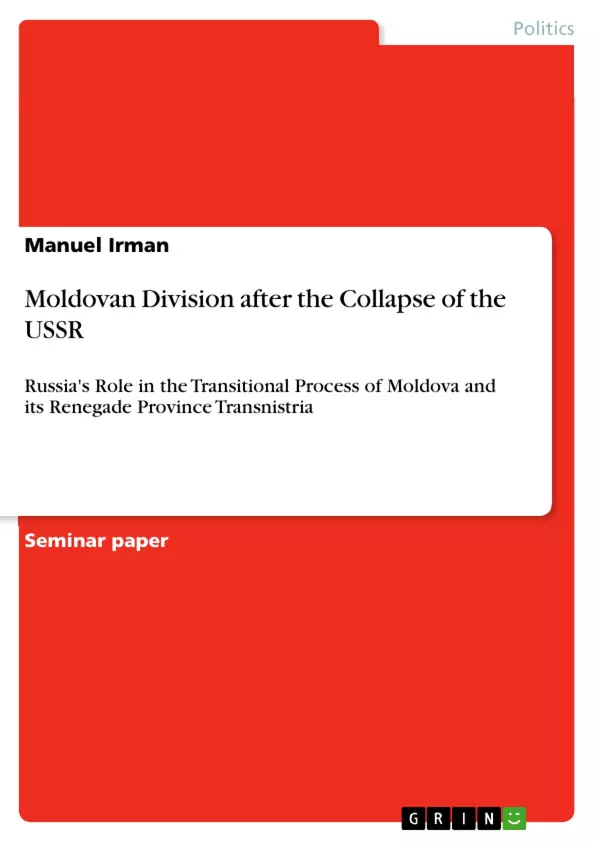Present-day Moldova is split into two entities. While the mainland is internationally recognised, the renegade Transnistrian province is only accepted and safeguarded by Russia. This paper is dealing with the question of how much Russia is involved in Transnistrian affairs and what objectives the regional great power is pursuing. Also of interest is the issue of Russia’s responsibility for the current state of politics in the region. Although being once under the umbrella of Soviet communism, the countries and entities in the Bessarabian region all departed differently towards democracy or authoritarian rule.
Inhaltsverzeichnis (Table of Contents)
- Introduction
- Historical Background
- Theory
- Transitional Process in Moldova and Foreign Impact
- USSR: The Beginning of the End
- Russian Mode of Transition
- International Impact on Moldova's Transition
- Moldovan Mode of Transition and Interstate Relations
- Western Influence on Central and Eastern European Countries.
- Political and Economic Developments in Comparison........
- Conflict Resolution at the Periphery of Europe
- Role of the Russian Army and Prospects for Divided Countries.
- Conflict Settlement without Progress..........\n
- Transnistria's Consolidation\n
- Conclusion
Zielsetzung und Themenschwerpunkte (Objectives and Key Themes)
This paper aims to analyze Russia's role in the transition of Moldova, particularly focusing on the unresolved conflict between Moldova and its breakaway province of Transnistria.
- Impact of Russian politics on Moldova.
- Russia's role in conflict resolution concerning the Transnistrian issue.
- Russia's strategic interests in Moldova.
- Historical development and its impact on multi-ethnicity, multi-nationality, and multilingualism in Moldova.
- The influence of the USSR's legacy on Moldova's current political situation.
Zusammenfassung der Kapitel (Chapter Summaries)
- Introduction: This chapter provides a concise introduction to the Transnistrian conflict, its historical context, and the paper's research questions.
- Historical Background: This chapter offers a historical overview of the region, starting from the 19th century, encompassing the Ottoman and Russian empires, the Romanian unification, and the Soviet era. It highlights the development of multi-ethnicity, multi-nationality, and multilingualism in the Moldovan area.
- Theory: This chapter presents theoretical frameworks for understanding the complex interplay between state-building, governance, and regime change in the post-Soviet space.
- Transitional Process in Moldova and Foreign Impact: This chapter delves into the process of transition in Moldova after the collapse of the USSR, examining the influence of Russia, the West, and international organizations.
Schlüsselwörter (Keywords)
The paper focuses on key concepts such as state-building, governance, regime change, post-Soviet transition, frozen conflict, Russian influence, Transnistrian separation, conflict resolution, and strategic interests.
- Citar trabajo
- M.A. Manuel Irman (Autor), 2010, Moldovan Division after the Collapse of the USSR, Múnich, GRIN Verlag, https://www.grin.com/document/182801



